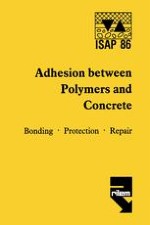1986 | OriginalPaper | Chapter
Crack Control of Reinforced Concrete Beams through Epoxy Bonded Steel Plates
Authors : R. Jones, R. N. Swamy, J. Bloxham
Published in: Adhesion between polymers and concrete / Adhésion entre polymères et béton
Publisher: Springer US
Included in: Professional Book Archive
Activate our intelligent search to find suitable subject content or patents.
Select sections of text to find matching patents with Artificial Intelligence. powered by
Select sections of text to find additional relevant content using AI-assisted search. powered by
Strengthening of concrete structures in situ by bonding steel plates to concrete surfaces using epoxy resins is now recognised to be an effective and convenient method of improving their performance under service loads or to increase their ultimate strength. The main advantages of the technique are that the operation can be carried out relatively quickly and simply even while the structure is in use. Although the technique has been widely used in various parts of the world, there is very little systematic information on the service load behaviour of plated beams, particularly in relation to cracking.In this paper comprehensive test data are presented on the effect of glued plates on the cracking behaviour of reinforced concrete beams strengthened with such plates. The variables studied in this project include plate thickness, glue thickness, layered plates and lapped plates. The structural behaviour of these beams was closely monitored during testing to destruction, and extensive crack measurements were made to evaluate the effectiveness of the glued plates on crack spacing and crack width.The paper will present a detailed analysis of the cracking data. It will be shown that maximum crack widths are substantially reduced in the plated beams compared to unplated beams. The test results are compared to existing crack width equations in design codes. New equations are developed to predict crack width in plated reinforced concrete beams.
